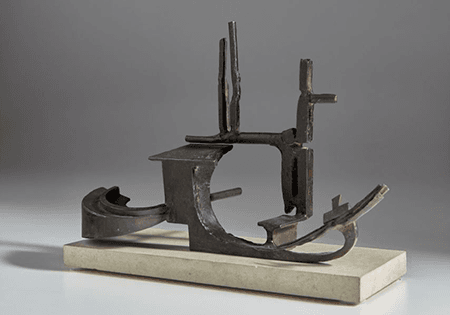Beginning in the late 1920s, Julio González, working in collaboration with Pablo Picasso, radically broke from the established traditions of sculpture. Rejecting the carving or modeling used for centuries, the artists worked directly with their medium, welding iron together to form assemblage sculptures. Though working side-by-side with Picasso during this period, it was González, born in Spain to a family of metalsmiths, who had the unique and necessary combination of technical skill and innate artistic understanding of the possibility offered by welded sculpture. Through this revolutionary technique, González was able to accomplish a feat not previously achieved in art, described in his own words as “drawing in space.”

Personnage allongé II, first conceived in iron circa 1936, was created during an intense period of production and invention within González’s oeuvre; the present work is a bronze cast after the original iron in 1939. It was in the early 1930s when González, by then working independently from Picasso, radically evolved his art from a planar approach to more starkly linear compositions. González not only changed his approach but also his subject matter during this period, shifting from his earlier focus on masks and heads to incorporate other classical subject matter rendered using his distinctive visual idiom.
In Personnage allongé II, the traditional reclining figure is transformed through abstraction and imbued with a modern energy. González’s style was rooted in Cubism at its core, and that fundamental quality is clear in the present work where the human body has been reduced to its most fundamental and essential components through an economy of line. The unadorned angularity of the form creates a dynamism within the figure: there is a sense of vitality and movement even when one is acutely aware of the innate permanence of the work’s medium. Beyond only tangible physical materials, González conceived of utilizing space itself as a vital and intrinsic element within his sculpture. “In order to give his work the maximum power and beauty, the sculptor is obliged to conserve a certain mass and to maintain the exterior contour,” the artist elucidated. “So it is on this mass that he has to focus his attention, his imagination, his technical skill, his way of conserving all its power... In traditional sculpture a leg is formed from a single block; but in sculpture that uses SPACE as a MATERIAL, that same leg may be HOLLOW, made at a STROKE within an assembly that thus forms one block. Traditional sculpture has a horror of hollows and empty spaces. This new kind of sculpture makes the maximum use of their potential and now thinks of them as an INDISPENSABLE material.”1
"Brancusi through direct carving in wood or stone, González through direct forging in metal — that the new vision of sculpture as we know it today was born."
—Margit Rowell, art historian and curator
There were at least four preparatory drawings for the work, including Reclining Figure with a Large Hand, 1936, now in the collection of The Tate Modern, London. The original iron version is housed at the Museo Nacional Centro de Arte Reina Sofía, Madrid; while a further bronze cast is in the collection of the Centre Pompidou, Paris.